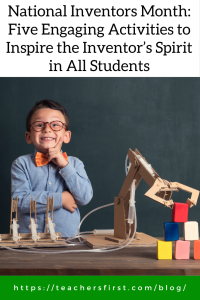Invention is a process: you don’t get there overnight
Louis Foreman
May is National Inventors Month, an excellent time to introduce your students to inventions and inventors and to discuss their character traits found, including perseverance, curiosity, and problem solving.
Celebrating the spirit of inventors and the invention process is an engaging way for students to learn that everyone is capable of becoming an inventor. Here are some ideas sure to inspire creativity in all students.
- Design and share Rube Goldberg Machines. These machines are defined as those that perform simple tasks using a complicated process.
- Introduce Rube Goldberg and his machines to students with this information from Wonderopolis (reviewed here).
- Share videos of Rube Goldberg machines to introduce students to some designs, such as “The Largest Rube Goldberg Machine Lighting Up a Christmas Tree” and “Rube Goldberg Easy Examples.”
- Ask students to identify a task for their machine and create their design. If you have access to a maker space, this is an excellent place for students to begin exploring and developing their devices.
- Plan and design a new invention. What might make your students’ life more manageable? Ask them to brainstorm ideas and create an invention that meets that need.
- There are several different frameworks for the problem-solving process. Select one for you and your students to follow as they begin the invention process, like the the four-step process or a six-step circular model which provide a collaborative and systematic approach to problem solving.
- If building a physical invention isn’t an option, ask students to share their designs using drawings and text descriptions.
- Hold an Invention Convention. Explore information about these events and inspiration for inventions.
- Invention Conventions use a seven-step model for the design process. Students complete the step-by-step process found in the curriculum to plan original, well-constructed inventions that address real-world problems.
- Use the provided curriculum to engage K-12 students in the invention process using themes such as Jungle Survival and Pitch Practice.
- Research and learn about inventors, focusing on the design process and what we learn from inventors.
- This CurriConnects book list features options for both well- and lesser-known inventors to include with your National Inventors Month activities.
- Did you know Walt Disney was fired from a newspaper job at 22 because he “lacked imagination and had no good ideas?” This article shares Disney’s story and eight other inventors who failed multiple times before achieving success. After introducing these stories to students, ask them to discuss and share a time when they had difficulty doing something but were eventually successful. Then, use these stories to encourage students to reflect on the skills and processes needed to complete the task successfully.
- Conduct an invention scavenger hunt in school or at home. What helpful inventions do we see around us daily?
- What inventions can students find at school that make their lives easier? Either make a list of items for students to find (such as electric pencil sharpeners and whiteboards) or divide students into collaborative groups to see who can create the most interesting list.
- Ask students to create a list of inventions around their house. After viewing the lists, ask discussion questions like, “What items have existed for a long time?” and “What items from your list would you want to update or invent a new product ro replace?”
- Make your scavenger hunt an active learning experience by using Goosechase (reviewed here) to integrate your invention scavenger hunt with another content area. For example, modify and use this template to help students explore erosion in their environment, then have students develop an invention that would control erosion better than the current solutions they see during the scavenger hunt.
Celebrating National Inventors Month is an opportunity to discover the fascinating stories behind the many revolutionary creations around us and how they transform our daily lives. Above all, it inspires students to recognize the power of perseverance, curiosity, and problem-solving, proving that anything is possible with these traits.
Do you have suggestions for introducing inventors and inventions into the classroom? Share your ideas below so we can learn together.



One thought on “National Inventors Month: Five Engaging Activities to Inspire the Inventor’s Spirit in All Students”